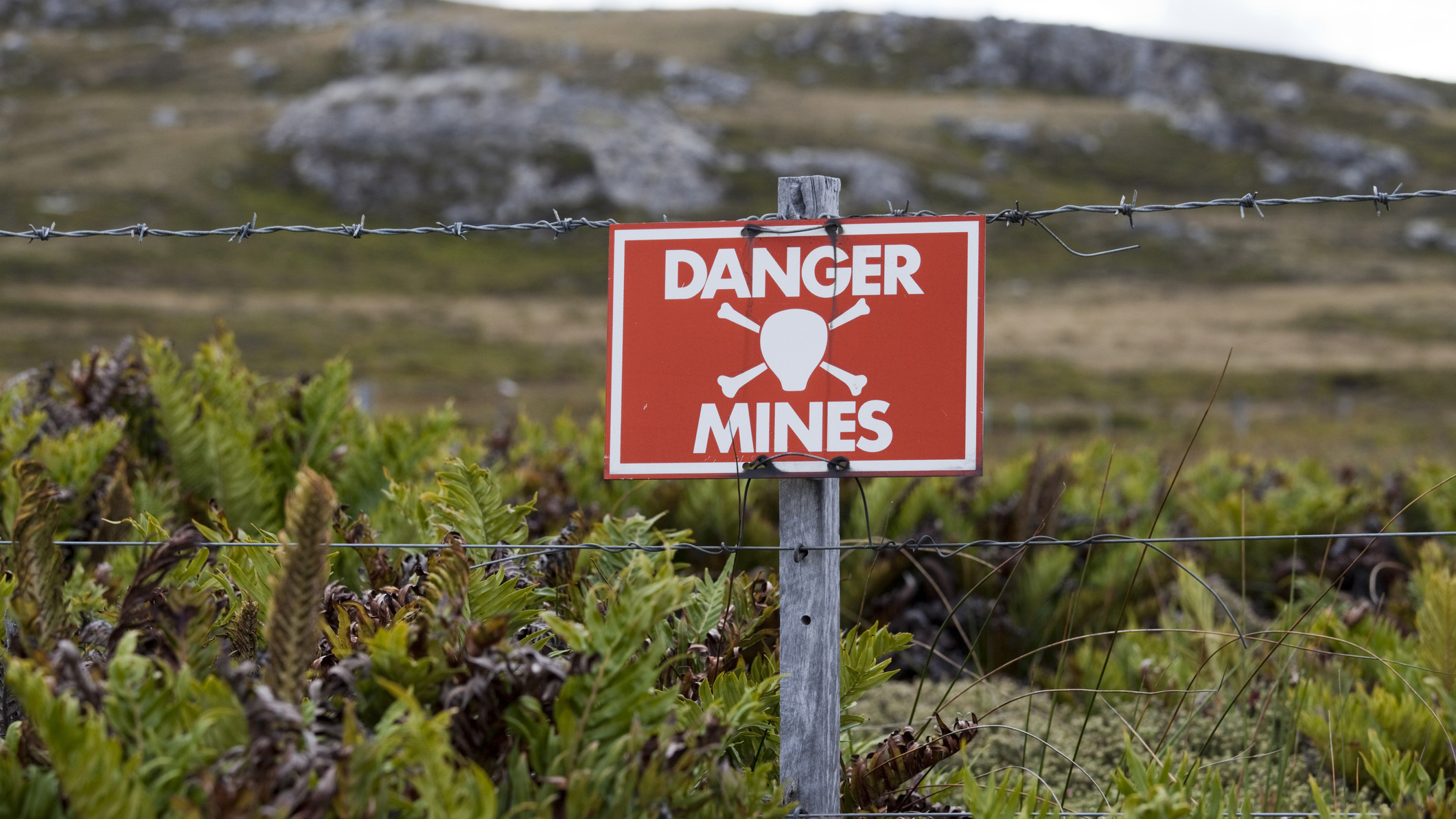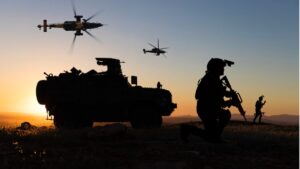ASX-listed Micro-X made a crucial bomb disposal breakthrough – and the US is watching

The Argus will be able to safely detect land mines. Pic: Getty Images
- Micro-X Argus bomb detection unit successfully field tested opening door to US$1.8 billion market
- The device removes need for a bomb disposal technician to get up close to a suspect package
- Argus has attracted attention of key defence and security agencies globally including the FBI
Adelaide-based cold cathode X-ray machine manufacturer Micro-X (ASX:MX1) is changing the way bombs are detected with its Argus IED X-ray camera pre-production unit successfully completing field testing for improvised explosive devices (IEDs).
First a quick lesson on the highly risky practice of bomb detection and disposal (we’ve all seen the movies). Up until now the bomb disposal technician must approach the suspect device or package to get a detector plate behind it to x-ray the contents without moving the device itself.
MX1’s Argus X-ray camera enables the technicians to capture high-resolution images using backscatter, or radiation reflected from the suspected device, which means there’s no longer a need for detector plates.
In the traditional method of bomb detection, moving a suspect package – if for example it’s against a wall – to put the detector plate behind it is highly dangerous.
But Argus, about the size of a large cereal box, enables bomb disposal technicians to safely image suspect packages remotely with greater clarity than ever before with the camera able to be deployed safely by an unmanned ground vehicle (UGV) or robot.
The Argus has attracted interest from key global players in the defence sector including the FBI, US military and police departments.
Latest testing of Argus
During testing, which occurred in South Australia over several days this month, Argus captured useful, high-definition backscatter images of an IED training aid through a car door.
Argus was also able to capture backscatter images of a shallow-buried anti-personnel mine, demonstrating its potential to support military missions such as large area clearance and buried threat detection, in essence helping to identify land mines for removal.
Argus is the only portable backscatter system available to bomb technicians that is capable of remote operation and stand-off imaging, with its communications system enabling images in testing to be viewed more than 1500 metres from the target.
MX1 said field tests achieved planned objectives and demonstrated Argus’s ability to produce high-definition backscatter images to considerably increase the rapid threat assessment capability, and safety, of military and police bomb technicians.
From hospitals to bomb detection
MX1 was founded in 2011 by former managing director Peter Rowland who recently retired and handed the realms over to the company’s former chief financial officer Kingsley Hall who was appointed CEO.
The company listed on the ASX in December 2015 and has become well-known for developing mobile X-ray machines, which are used in hospitals, veterinary practices and defence medical bases using its breakthrough cold cathode X-ray technology.
The tech uses a carbon nanotube instead of an imprecise heated filament and can be shrunk down to a fraction of the size of traditional X-ray devices.
Its first partnership with Carestream Health led to the release of the DRX-Revolution Nano, a mobile X-ray machine used for high intensity workflow diagnostic medical imaging in hospitals around the world.
As a core technology partner in the Australian Stroke Alliance, MX1 is developing a lightweight CT scanner for use in road and air ambulances that will provide point of care early stroke diagnosis, reducing time from stoke onset to treatment.
The Rover Military aims to to increase the availability, quality and ease of providing medical X-ray capability in military settings. It is currently being used in military hospitals in war-torn Ukraine.
Rover Veterinary is a highly portable X-ray machine that can be used at the operating table rather than only in a lead-lined X-ray room.
The company said as animals can’t be moved while under anaesthetic, Rover Veterinary exponentially increases the ability of vets to diagnose and treat animals using X-ray equipment.
MX1’s Rover and Nano devices have been sold in 26 countries across the world with the Rover procured by the WHO for use in Pacific Island nations.
Beyond medicine, MX1 is making a name for itself in security and defence.
In September 2022 the US Department of Homeland Security awarded MX1 an extension on its development contract for its Miniaturised CT Baggage Scanner and exercised an option to continue the company’s Passenger Self-Screening Checkpoint design. The two DHS contracts are now valued at US$4.5 million.
Their Miniature Baggage Scanner uses 3D CT reconstruction and backscatter X-ray technology to detect hidden threats without the need to unpack bags, while its Airport Self Service Checkpoint aims to address the congestion and inefficiency in airport security lanes.
It is also working on an advanced IED X-ray camera for counter IED operations. The Stand-Off Rapid Assessment X-ray Camera can be deployed remotely through a UGV and easily transported to different locations.
The Argus concept originated from the request of the Australian Department of Defence some years ago to demonstrate a proof of concept for stand-off imaging of IEDs.
MX1 has been advancing development of the Argus device trying to make it as small and lightweight as possible to meet user’s needs.
All proprietary components of the Argus are manufactured in-house in Australia including the X-ray tube and the high-powered generator.
Key catalyst achieved
Achieving that key catalyst along with Hall’s appointment comes just as MX1 pivots to a stronger commercial focus.
“It makes the detection of IEDs much safer because the unit can be robot deployed and the technician can be some distant away and so they don’t have to be in and amongst the danger,” Hall told Stockhead.
“The field testing is a key catalyst because it demonstrates the key capabilities of the unit.”
He said the Argus opens the door to an addressable market of US$1.8 billion based on the number of bomb disposal teams worldwide.
“The Argus a significant opening into defence and security markets globally, which are significant,” he said.
“The Rover, while it has been employed in military situations, is still a healthcare product whereas Argus enables us to reach into global security and defence markets.”
He said further to the field testing, MX1 will now complete demonstration units for customers.
“We will be commencing demonstrations in the coming weeks,” he said.
MX1 is also taking units to the International Association of Bomb Technicians and Investigators conference in the US in June.
Morgan’s analyst Scott Power said completing the field testing of Argus was an important milestone for MX1.
“We now await customer demonstrations which are planned in the next few weeks and then potential commercial orders with defence and police to follow,” he said.
“The commercial launch of the Argus has been delayed for a number of quarters and it now appears all technical issues have been resolved.
“We believe the Argus has the potential to be a major revenue and profit generator for MX1 – offering higher margins and less regulatory hurdles to pass through, compared to its portable x-ray device.”
Morgans has a speculative Buy rating and 12-month target price of 28 cents on Argus. The company’s share price rose 3.45% yesterday on news of the Argus testing results.
The MX1 share price today:

UNLOCK INSIGHTS
Discover the untold stories of emerging ASX stocks.
Daily news and expert analysis, it's free to subscribe.
By proceeding, you confirm you understand that we handle personal information in accordance with our Privacy Policy.








